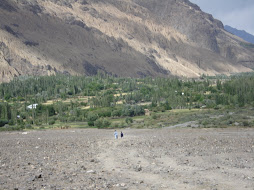ISLAMABAD: The concept of hunting and shooting animals for sport would strike many as barbaric. That is even truer of trophy hunting where the objective was not food but handsome heads or sets of horns to decorate walls.
Sad and pathetic it may be but trophy hunting is now considered a vital conservation tool to help conserve threatened species and their habitats in Pakistan's Northern Areas where flame-horned markhor, Ibex and blue sheep, to mention some, flourished.
Found at altitudes ranging from 8,000 to 13,000 feet in the Himalayas, flame-horned markhor risked extinction the most due to habitat destruction and illegal hunting with sophisticated weapons. However, due to conservation efforts and a new preservation tool, trophy hunting, markhor figures rose from 1,000 to an estimated 1,500 in 2008.
This controversial leisure industry (or trophy hunting) had drawn attention to these areas, locally and internationally, from the USA, Spain and Germany. Hunters are now tramping through rough country and enjoying the thrill of the chase, keeping still upwind and lining up for the perfect shot.
This year, US-based Pakistani Syedullah Khan Piracha paid $55,000 trophy hunting fee, the highest ever collected to hunt markhor. Last year, a German hunter had paid $40,000 to hunt down a flame-horned markhor. Simply put, hunters are paying more and more for exotic animals to be kept alive – which had to be a good thing.
“Managed properly, trophy hunting can provide a source of jobs and incomes and so gives local communities a reason to protect wildlife and habitats that might otherwise be lost to deforestation and illegal hunting etc,” said Dr Mayoor Khan who is Programme Manager Wildlife Conservation Society.
Dr Khan, who has done his PhD in status and distribution and conservation of flare-horned markhor in Northern Areas and Kohistan from Karachi University, said trophy hunting was a well-thought concept to protect endangered animals like the flare-horned markhor or ibex and blue sheep in Pakistan.
Dr Khan believed that bringing local communities on board had played significant role in conservation of wildlife and its habitat.
“The community keeps some 80 per cent of their share of trophy hunting fees and the rest goes to the government. Their share runs into hundreds of thousands of rupees. The practice saves resources. It provides alternate incentives, gives them a sense of responsibility and ownership to protect wildlife and its habitat.”
According to restrictions laid down by the government, international conservation NGOs and wildlife experts in this joint venture, hunting season opens once a year. Hunters were permitted to kill three animals last year. And only four hunters were permitted to hunt this year, Dr Khan said as he explained the thrill of paying to kill an animal.
“Trophy hunting did not affect animal population. Certain areas have been declared off limits. And hunters are allowed to hunt only if there is a trophy hunting size animal available in the wild. Hunters can kill eight blue sheep and 50 ibex for a price that goes up during biddings,” said Mohammad Jamil who is chairman Mountain Conservation and Development Programme (MCDP).
“The Northern Areas are considered one of the most important stronghold areas for these vulnerable species. The MCDP’s role is critical in working to conserve the markhor, the ibex and other animals,” Jamil said.
Saturday, September 6, 2008
Subscribe to:
Post Comments (Atom)
Awesome and rugged

Beauty of Chitral

Kishmanja, a beautiful village in Yarkhun valley
Lush green

DIZG: threatened by floods

The legendary village of Ayun in Chitral

On way to Bumburet
Dizg, Yarkhun

Blog Archive
-
▼
2008
(197)
-
▼
September
(60)
- The wishy-washy Ruet Committee
- Leaseing of resources to outsiders slammed
- Transparency in zakat card distribution stressed
- Tributes paid to martyred policemen
- Hiring of outsiders as grain supervisors opposed
- Most schools in Chitral without science teachers
- Boy killed, mother injured in accident
- PTCL phones partially restored
- TOURISM IN THE DOLDRUMS
- Road to Yarkhun valley reopens after five months
- Hotel Haut Monde
- Chitrali injured in Marriott blast improving
- Jashn-i-Chitral could have attracted terrorists, n...
- Five killed, one injured in accident
- Eight feared dead in Chitral accident
- Call to enhance Chitral border security
- MNA angry over non-release of uplift funds
- Car donated to DHQ hospital used as taxi by doctor
- Protest held in Chitral against price hike
- Bird hits Chitral-bound PIA plane
- Killed suicide bomber used fake Chitrali identity
- Chitral peace body vows to keep militants away
- Body of Marriott blast victim buried in Bang
- Students suffer due to lack of hostels
- Cancellation of Jashn-i-Chitral justified
- Over 75pc work on Lowari tunnel access roads compl...
- Two tribes in Bumburet end feud; ox goes to the Sh...
- Chitral residents reject raise in water rates
- Chitrali victim of Marriott blast dies
- Chitrali injued in Marriott blast critical
- Chitralis the music lovers
- Floods can wipe out Kalash valley, say elders
- Woman released on HR activists' intervention
- Boy commits suicide in Kosht
- Three Chitralis injured in Marriott blast
- Chitralis working in Marriott Hotel are safe
- Freezing of Chitral's uplift funds criticised
- Suicide blast at Marriott Islamabad
- Funds for Yarkhun bridge released
- Decision to cancel Chitral festival slammed
- Flashfloods damage schools in Reshun
- MNA's decision to join PPP hailed
- Jashn-i-Chitral cancelled
- British paraglider injured in Chitral
- Two-month marble mosaic training workshop begins
- HR body elects office-bearers for Mastuj
- Call to open passport office in Chitral
- <!--google_ad_client = "pub-2976157137802820";/* 7...
- MPA seeks more uplift funds for Mastuj area
- Public library still a far cry in Chitral
- Chitral farmers provided incentives
- PPP Chitral congratulates Zardari
- Five-day Jashn-i-Chitral from Oct 11
- Who killed 'em?
- Trophy hunting becomes vital conservation tool
- Asif Zardari elected President of Pakistan
- Kalash village threatened by floods
- Death on the Farang Bur
- Marble city planned in Chitral
- Call to appoint doctors in health centres of Mastuj
-
▼
September
(60)
About Me

- Zar Alam Khan Razakhel
- Village Dizg, Yarkhun valley, Chitral, Pakistan
- I blog at http://chitraltoday.net (ChitralToday) about Chitral, its people, culture, traditions and issues. I have been writing about Chitral since 2000. Chitral is a scenic valley in the extreme north-west of Pakistan.
No comments:
Post a Comment